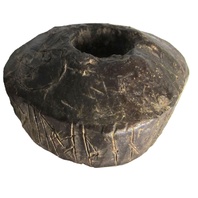
Viking Objects
Saltfleetby Spindle Whorl (LIN-D92A22)
A lead spindle whorl found at Saltfleetby St Clement, Lincolnshire, and inscribed with runes. The dating of the spindle whorl is uncertain, and dates in the late Viking Age, the early eleventh century, or even the twelfth century, have been suggested. The spindle whorl is inscribed with Scandinavian runes that appear to mention the Norse gods Odin and (possibly) Heimdall. The object is likely to have been produced locally, though the runes demonstrate contacts with the Scandinavian world of the time, perhaps especially Norway. John Hines has suggested the translation ‘Óðinn and Heimdallr and Þalfa, they are helping you, Úlfljót, and …’. For further discussion of the text, see the open-access article by Jesch referenced below. For more on runes, see our Runes page.
Read More
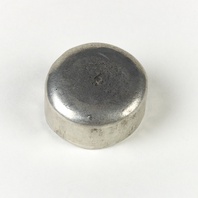
Viking Objects
Reproduction Round Weight
A round lead weight made in an open mould, as shown by the rounded edges of the top which indicate shrinkage in the mould.
Read More
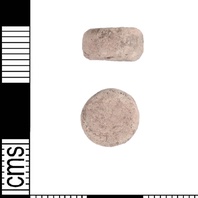
Viking Objects
Round Lead Weight (PUBLIC-2DDD03)
Weights are an important form of evidence for Viking Age commerce and the use of standards across the different economic systems within which Vikings were integrated. Many of the weights discovered, particularly ones in Ireland and those of Arabic type, suggest that a standardized system of weights existed in some areas. These standard weights, alongside standard values of silver, are what allowed the bullion economy of Viking occupied areas to function. A bullion economy was a barter economy that relied on the exchange of set amounts of precious metal in various forms, such as arm-rings or coins, for tradable goods, such as food or textiles. Each merchant would have brought their own set of weights and scales to a transaction to make sure that the trade was conducted fairly.
Read More
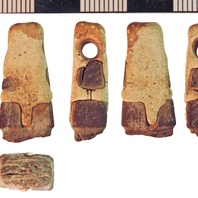
Viking Objects
Whetstone (NLM-7FA566)
Whetstone fragment, possibly made of slate that looks like ‘phyllite’, where the the broken end of the hone has been sheathed in lead, which has held its parts together. This is an unusual example of the repair of a personal hone so it could be continued to be carried and used after its breakage. The hone would originally have been of a tapered bar-shaped form and was sawn to shape. Hones of this size were personal items to be carried and worn at the belt alongside the knife they sharpened. True ‘phyllite’ hones came from Telemark in Norway, and were among the first imported whetstones of the Viking Age. A range of other banded and coloured stones, many found in graves at Birka, were adapted for similar use, and their fine appearance was as important as their usefulness as sharpening stones.
Read More
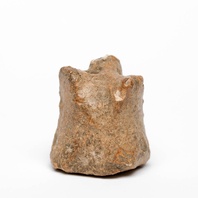
Viking Objects
Lead Gaming Piece (CM.574-2010)
This solid sub-circular based lead gaming piece has three projections on the top. This and similar pieces have also been interpreted as weights although the gaming piece interpretation is more secure. Pieces like this would have been used to play hnefatafl and/or Nine Men’s Morris, both of which are known to have been played in Scandinavia in the Viking Age.
Read More
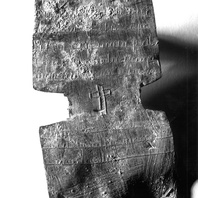
Viking Objects
Inscribed Lead Plaque (LCNCC:1996.64.045)
This lead plaque of uncertain function has a cross incised in its centre and a long Latin text in the Roman alphabet. Like the Saltfleetby spindle whorl, this inscription, too, calls on a divine power, in this case Christ. Between them the two inscriptions represent different responses to literacy and religion in the same time period in neighbouring but probably different communities. (Cumberworth is about 15 miles south of Saltfleetby, in an area with many Scandinavian place-names.) This fragmentary inscription begins with a cross and XPI, the sign for Christ, and after a gap in the text ends with ‘he who by the power of the cross redeemed the world from death, shattered hell or threw open heaven’. The object is dated to the late 10th or 11th century on the basis of the similarity of the writing to contemporary manuscripts.
Read More
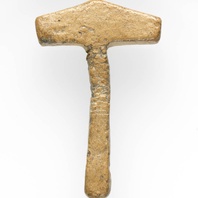
Viking Objects
Lead Thor’s Hammer Pendant (CM_569_2010)
A lead Thor’s hammer pendant with a trapezoidal head and pierced base. These may have been worn to show devotion to the god Thor, or to secure the god’s protection, although there is little evidence to support this interpretation. Pendants like this have been found made of lead, copper alloy, silver and gold, showing that many different strata of society could have worn them. For more information on Scandinavian jewellery in England check out our blog: Brooches, Pendants and Pins: Scandinavian Dress Accessories in England.
Read More
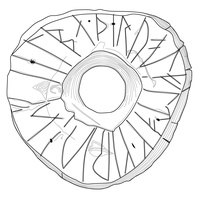
Viking Designs
Drawing of the Saltfleetby Spindle Whorl
Drawing of a lead alloy spindle whorl from Saltfleetby, Lincolnshire showing part of the runic inscription. For further information, see the entry for the original item.
Read More
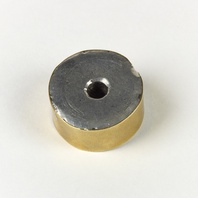
Viking Objects
Reproduction Copper Alloy-Edged Lead Weight
A lead weight edged with a copper alloy band.
Read More
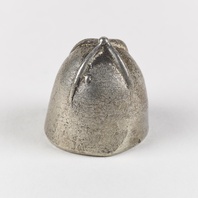
Viking Objects
Reproduction Lead Gaming Pieces
Reproduction lead gaming pieces of a type commonly found across the East Midlands, including at the Torksey Viking camp. The reproductions are tin alloy while the originals were made of lead. These gaming pieces would have been used to play hnefatafl or Nine Men’s Morris, both of which are games known to have been played by Scandinavians throughout the Viking diaspora. It has also been suggested that these might have been weights.
